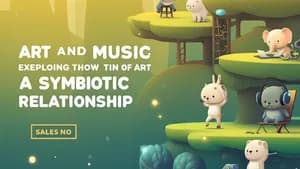Cultural Expression: Art and Music as Guardians of Identity
From ancient times to the present day, art and music have played an integral role in shaping cultural identities. This article explores how these disciplines have been used to celebrate cultural heritage, express national pride, and foster a sense of community.
The Power of Visual Art
Think about the iconic images that represent your country or region. Are there particular colors, symbols, or styles that come to mind? These are all elements of visual art that have become deeply ingrained in our collective understanding of who we are. Take, for example, the vibrant colors and intricate patterns of traditional Indian saris, the bold brushstrokes of Chinese calligraphy, or the majestic pyramids of ancient Egypt. These works of art serve as tangible reminders of our ancestors, their beliefs, and the values that have shaped our cultures.
Beyond simply celebrating heritage, visual art can also be used to express national pride and unify people. Think of the powerful images that emerged during times of social change or political upheaval. Art can provide a platform for dissent, provoke dialogue, and inspire social action. In the 1960s, for instance, artists like Andy Warhol and Roy Lichtenstein challenged societal norms with their provocative works, while artists like Pablo Picasso and Frida Kahlo used their art to express political and social commentary. These are just a few examples of how visual art can be a powerful tool for social change, fostering dialogue, and uniting people around shared values.
The Language of Music
Music transcends language barriers. It is a universal language that speaks to our emotions and connects us to our shared humanity. Think about the music that moves you, the melodies that evoke memories, and the rhythms that make you want to dance. These are all expressions of human experience that resonate across cultures. Consider the vibrant folk music of the Andes, the soulful melodies of traditional Irish music, or the powerful rhythms of African drumming. These musical traditions are not only expressions of cultural heritage but also convey stories, beliefs, and shared experiences of the people who created them.
Music can also be a powerful tool for cultural exchange and understanding. When we listen to music from other cultures, we open ourselves up to new perspectives and gain a deeper appreciation of the world around us. Music can also help break down barriers between people, fostering a sense of empathy and understanding. Through music, we can learn about the joys and sorrows, the hopes and dreams, of people from different backgrounds.
Art as a Platform for Identity
Art and music can empower individuals and communities to define their own identities and celebrate their uniqueness. In a world where we are often bombarded with messages about conformity, art provides a space for self-expression and creativity. When you create art, whether it's painting, dancing, writing poetry, or playing an instrument, you are expressing something about yourself that is unique and personal. This act of creation is a form of self-discovery and can help you gain a deeper understanding of who you are and where you belong.
Furthermore, art can be a powerful tool for social change and advocacy. Art can be used to raise awareness about important social issues, promote tolerance and understanding, and empower marginalized communities. For example, during the civil rights movement in the United States, African American artists used their art to express their struggles and fight for equality. This use of art to promote social change is a powerful reminder that art is not only a form of self-expression but also a powerful tool for social justice.
Finding Your Voice: Practical Tips
Here are some practical ways you can engage with art and music to explore your identity and connect with your culture:
-
Explore Your Local Art Scene: Visit museums, galleries, and community centers that showcase local art. This is a great way to learn about the history and culture of your community. You might even find inspiration for your own creative endeavors.
-
Engage in Music: Learn to play a musical instrument, join a choir, or attend live music performances. Music can be a great way to express your emotions and connect with your heritage.
-
Create Your Own Art: Pick up a paintbrush, a pen, or a musical instrument and express yourself creatively. There's no right or wrong way to create art. It's all about exploring your own unique voice.
-
Learn About Traditional Art Forms: Research the traditional art and music of your family's heritage. You can learn about the techniques, symbols, and stories that are embedded in these art forms.
-
Share Your Art: Don't be afraid to share your art with others. You can post it online, participate in local exhibitions, or simply show it to your friends and family. Sharing your art can be a powerful way to connect with others and inspire them to explore their own creativity.
Conclusion
Art and music are powerful forces that shape our identities and connect us to our shared humanity. They are not only expressions of cultural heritage but also platforms for self-expression, social change, and cultural exchange. As you learn more about art and music, you will discover a deeper appreciation for your own culture and a greater understanding of the world around you. Embrace the power of art and music to connect, inspire, and empower you to find your voice in the world.

